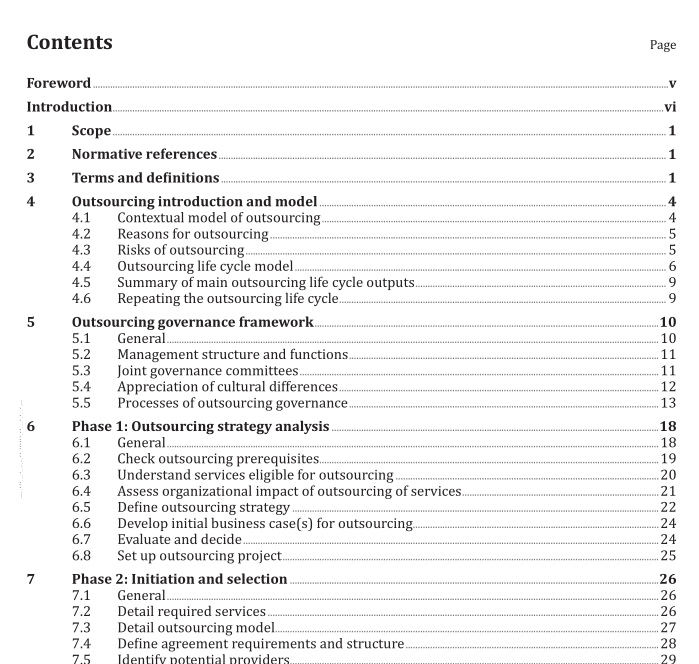ISO 37500 pdf download

ISO 37500 pdf download Guidance on outsourcing
a) Absence of a strategy: Outsourcing contributes a risk to the overall effectiveness of the organization if no formal strategy and vision is set by the leadership of the client. Outsourcing should be a carefully chosen strategy based on sound business decisions.
b) Poor understanding of environment dynamics: As explained in 4.1, an organization constantly struggles to create equilibrium with its surroundings. In many cases this may affect the outsourcing arrangement, forcing changes to be able to deliver value. Adaptability becomes more important when dealing with outsourcing core processes, for example by adding innovation or change services to the outsourcing agreements. Outsourcing governance, therefore, should be more important to facilitate collaborative business relationships.
c) Blind focus on cost reduction: Although outsourcing can lead to substantial cost reduction, an organization should pay attention to the overall impact and risks of outsourcing. By doing this organizations can factor in issues that could occur, particularly those who are relatively inexperienced in outsourcing and who often tend to focus too much on cost reduction. Organizations tend to underestimate the set of outsourcing governance processes and the staff required to manage the demand and integration as well as monitoring and steering of the provider. This often results in an overly optimistic or unrealistic business case.
d) Underestimated business impact: outsourcing: Especially when it concerns core business processes, can have a profound and unexpected effect on a client’s culture, work morale and business relationships. Therefore, clear visible strategic leadership is required to guide the organizational change.
e) Poor cultural compatibility: An outsourcing arrangement generally covers a certain period. During this period, client and provider should collaborate on different levels. If the organizational and management culture differ significantly, conflicts and disputes are often managed in an ineffective manner. A client should understand the work dynamics in order to be able to search for a suitable provider.
f) Poor understanding of the process: Transferring responsibility and control are key elements of outsourcing. During an outsourcing arrangement, the client’s understanding of the process may fade. People may change jobs and the provider may make changes to the process. Clear understanding of the processes from start to finish is important for a successful start and the inevitable exit. Hence, it is important to understand the arrangements around knowledge management and intellectual property.
g) Poor relationship management: Outsourcing is by definition a relationship between stakeholders and the success of the relationship is the most fundamental factor in the success of the arrangement for both stakeholders. A successful relationship should often ensure that problems, which will inevitably arise in every arrangement, are able to be effectively addressed. A poor relationship may, at worst, even result in the termination of what is a potentially successful collaboration.
4.4 Outsourcing life cycle model
In order to obtain the desired value and mitigate risks associated with outsourcing, this International Standard provides a high-level, relatively easy-to-comprehend outsourcing model which aims to support stakeholders to understand:









